Coconut processing generates a substantial amount of waste, presenting a challenge for sustainable agricultural practices. Various methods exist to address this issue, each with its unique characteristics and environmental implications. In this comprehensive exploration, we delve into the intricacies of coconut waste treatment, highlighting the nuances of different approaches and emphasizing the role of cutting-edge technology.
Incineration:
Incineration stands out as a conventional method for coconut waste disposal. The process involves subjecting the waste to high temperatures, resulting in its reduction to ashes. This approach not only minimizes the volume of waste but also generates thermal energy. However, coconut shell charcoal making machine enthusiasts argue that incineration may release harmful emissions, contributing to air pollution.
Landfilling:
Landfilling remains a common practice, involving the burial of coconut waste in designated areas. While it effectively reduces surface waste, concerns arise regarding potential soil and water contamination. The need for sustainable alternatives prompts a critical examination of the long-term environmental impacts associated with landfilling.
Composting:
Turning our attention to organic solutions, composting emerges as an eco-friendly method. By blending agricultural residues with organic matter, composting creates a nutrient-rich soil conditioner. This approach aligns with the principles of circular economy, transforming coconut waste into a valuable resource for enhancing soil fertility.
Anaerobic Digestion:
In the realm of biogas production, anaerobic digestion takes center stage. This process involves breaking down organic matter in the absence of oxygen, producing biogas as a byproduct. While anaerobic digestion showcases promise in harnessing renewable energy, its feasibility for coconut waste treatment warrants meticulous consideration.
Biochar Production:
Venturing into the realm of advanced technologies, biochar production introduces an innovative avenue for coconut waste utilization. Employing the coconut shell charcoal making machine, this method converts waste into biochar—a stable form of carbon. Biochar finds applications in agriculture, acting as a soil amendment that enhances nutrient retention and promotes sustainable farming practices.

Hydrothermal Carbonization:
For those inclined towards cutting-edge thermal treatments, hydrothermal carbonization (HTC) emerges as a promising option. HTC involves subjecting coconut waste to high temperatures and pressures in a water-rich environment, transforming it into hydrochar. This carbon-rich material holds potential for diverse applications, including soil improvement and carbon sequestration.
Pyrolysis:
Pyrolysis, a thermal decomposition process in the absence of oxygen, offers an intriguing avenue for coconut waste transformation. The resulting bio-oil, biochar, and syngas hold promise for renewable energy generation and bio-based products. The synergy between pyrolysis and the coconut shell biochar pyrolysis equipment unveils a pathway to maximize resource utilization.
Waste-to-Energy Conversion:
In the pursuit of sustainable energy solutions, waste-to-energy conversion gains prominence. This involves harnessing the calorific value of coconut waste to generate electricity. While this method addresses energy needs, its economic viability and environmental impact necessitate careful evaluation.
Comparison and Considerations:
When comparing these methods, a nuanced understanding of their advantages and drawbacks is essential. Factors such as environmental impact, energy efficiency, and resource recovery play pivotal roles in decision-making. Traditional methods like incineration and landfilling, while effective in waste reduction, face scrutiny due to their environmental implications. On the other hand, emerging technologies like hydrothermal carbonization and pyrolysis offer more sustainable alternatives but require careful implementation.
The integration of the coconut shell charcoal making machine into waste treatment processes exemplifies the intersection of technology and sustainability. This machine optimizes the conversion of coconut shells into valuable charcoal, aligning with the broader goal of circular economy principles. The intricate design and functionality of this machine contribute to enhancing the overall efficiency of coconut waste utilization.
In conclusion, the treatment of coconut processing waste encompasses a spectrum of methods, each with its unique attributes. From traditional practices to state-of-the-art technologies, the key lies in striking a balance between waste reduction, resource recovery, and environmental stewardship. As we navigate the intricate landscape of coconut waste treatment, the synergy of innovation and sustainable practices paves the way for a greener and more resilient future.


 留言列表
留言列表
